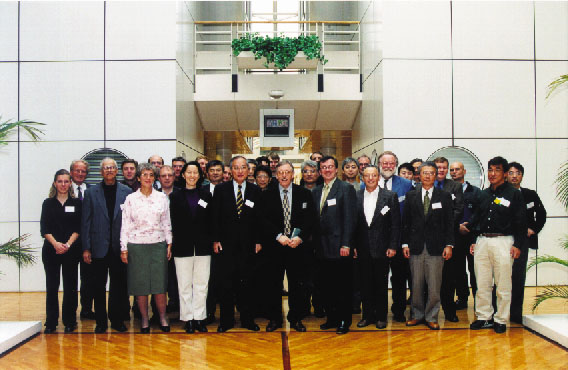Introduction
2001 was a very productive year for the ESRF. The machine (linac, synchrotron, storage ring) performed extremely well, providing almost 5500 hours of beam. The overall availability was close to 97%, a new record. For our Users, reliability is as important as raw flux, and here the Machine Division continued to improve the machine's performance with a mean time between failures of 46 hours. To answer the needs of a wide and varied User community, the ESRF offers a variety of machine modes, with a significant proportion (30% of the total number of shifts delivered) in single-bunch or 16-bunch for time-resolved studies. During the last year there was a move from the previous routine high-brilliance mode (2 x 1/3 filling) to uniform mode, which has advantages as far as beam lifetime and detectors are concerned. Other improvements and advances include the installation and operation of 10 mm NEG-coated chambers, the installation of the first of a series of in-vacuum undulators, and the start of a programme to increase the beam current from the present 200 mA. This latter project is particularly exciting and during the first tests in November, a stable current of 250 mA was achieved.
These Machine improvements were mirrored in an extremely high level of activity on the beamlines. As well as carrying out an ambitious scientific programme on 40 beamlines, many of the ESRF's beamlines were refurbished or upgraded. For example, there was excellent progress in the installation of the former BM16 powder diffractometer in its new position on ID31 and also in the restart of operation of the Dragon beamline on the new dedicated section ID8. An ever-increasing number of guest scientists visit the ESRF. During 2001, there were some 5000 visits by more than 3000 individual Users. These scientists carried out about 800 distinct experiments, resulting in more than 400 publications in scientific journals. For example, in 2001 ESRF staff and visitors contributed to at least 29 papers in Nature and Science, 44 papers in Physical Review Letters and Europhysics Letters, and 52 papers in the Physical Review. These figures attest both to the international dimension and to the quality of the research carried out at the ESRF.
A major project for the ESRF's further development is the Partnership for Structural Biology with the EMBL, ILL and IBS. The aim of this project is to provide a European focus for the vibrant and expanding field of structural biology. The ESRF will build a new state-ofthe-art beamline with two stations for macromolecular structure determination. A major contribution will also be made to the construction and operation of a new laboratory/office building, specifically designed for the needs of the PSB. The ESRF's Medium Term Scientific Programme was further refined in 2001 to provide a road-map for scientific directions over the next five years. There are projects to enhance our facilities for engineering studies, to examine the possibilities of combining synchrotron radiation with high magnetic fields, and to develop photoemission spectroscopies in the X-ray region. In parallel, we shall continue to enhance and improve our beamlines and the machine this enhancement programme is a cornerstone of the ESRF's success.
 |
|
Patricipants in the APS, ESRF, SPring-8 Three-way Meeting. |
Among many significant events during 2001, we highlight the Three-way Meeting with our colleagues from the Advanced Photon Source (USA) and SPring-8 (Japan). This meeting, on 14 and 15 November 2001, proved valuable as an exchange of ideas at both the professional and personal levels. The three Directors-General, none of whom had been in post for more than a few months, had the opportunity to meet for the first time and exchange views on the challenges encountered when leading these large and diverse organisations.
W.E.A. Davies, P. Elleaume, P.F. Lindley, F. Sette, W.G. Stirling
(January 2002)



